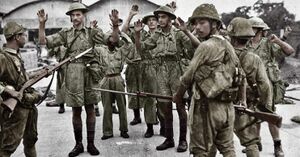Battle of Ayermer (1936)
| Battle of Ayermer | |||||||
|---|---|---|---|---|---|---|---|
| Part of Second Great War | |||||||
 Burgundie's soldiers surrendering | |||||||
| |||||||
| Belligerents | |||||||
|
|
| ||||||
| Commanders and leaders | |||||||
|
|
| ||||||
| Units involved | |||||||
| Corummese Armed Forces | Army of Burgundie | ||||||
| Strength | |||||||
| 70,000 | 40,000 | ||||||
| Casualties and losses | |||||||
|
3,543 killed 6,855 wounded |
2,654 killed 37,000+ captured | ||||||
The Battle of Ayermer, also known as the Siege of Ayermer took place in the Alshar theater of the Second Great War. Long a point of contention between the two empires and a dangerous impediment to Corummese naval forces in the area, the island was captured after four months of heavy fighting both in land and in the surrounding waters. The surprise assault on the island marked Corummese entry into the war, after a secret protocol was signed with Caphiria in which the Qian agreed to open another front to draw Burgundie's resources thin. The loss of Ayermer and its garrison was a heavy blow to Burgundie's armed forces and its capture allowed the Harmonious Flotilla Invincible to move into the western Taizi Sea and threaten Burgundie's colonies.
Background
See Also: Rusana Levantine Exploration, Alshar Quasi-Wars
The island of Ayermer had long been administered as the Ayermer Colony by Burgundie since at least 1616 by the Ularien Trading Company, which was renamed the Marialanii Ularien Trading Company in 1705. The company maintained the island of Ayermer as a trading post and as a part of La Garrote to control trade and fight piracy in the Pukhtun Sea. This primarily impacted Corummese trading traversing westerly. Attempts were made by the Qian dynasty to take the island, most notably in the 1685 Siege of Ayermer which was ultimately repulsed. Corummese naval merchant fleet developed alternate routes to the east to avoid Ayermer and while relations remained sour, Audonia was a market it could not exploit. Burgundie's mercantile outpost in southern Rusana fell around 1802 but the island continued to be strongly held and supplied from Pukhgundi. The development of new naval technologies and sea based artillery and the introduction of these technologies into the Corummese arsenals in the late 1800's and early 1900's gave military planners new hopes for taking the island in a future war.
At the onset of the Second Great War a secret protocol was signed with the Imperium of Caphiria that stipulated that the Qian would initiate an attack on Burgundie's possessions in Alshar, and in exchange three fully equipped battleships(originally meant for Zaclaria) would be transferred to Corumm. These vessels would have to traverse a circuitous route and would not be able to participate in the battle. Corummese preparations for the attack took place over the first half of 1936, with great care being taken to maintain operational secrecy. New aircraft runways, supply depots and a radar station were constructed in Gochi island to support the invasion. Nonetheless the Ayermer garrison commander, (insert burg man here), was suspicious of Corummese fleet movements and requested that more reinforcements be sent to the island, which was granted? The start of the invasion was set for August 1936, while most of Burgundie's naval assets were focused on (insert random burg front).
Opposing forces
Corummese Qian forces
Harmonious Flotilla Invincible (Admiral Hong Ming)
Western Squadron composed of 30 vessels divided as follows:
- Six battleships
- 14 destroyers
- 10 minesweepers
Ayermer Expeditionary Force (General Qiu Heng)
Approximately 70,000 men
- 1st Imperial Marines Division
- 12th Imperial Marines Division
- 32nd Imperial Infantry Division
- 5th Imperial Infantry Division
- Zaclarian Volunteer Brigade